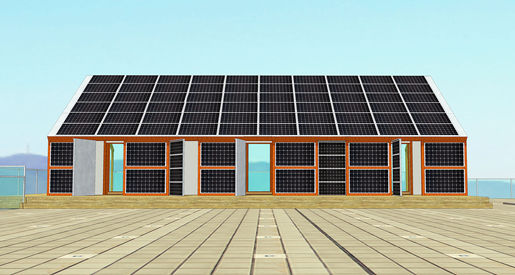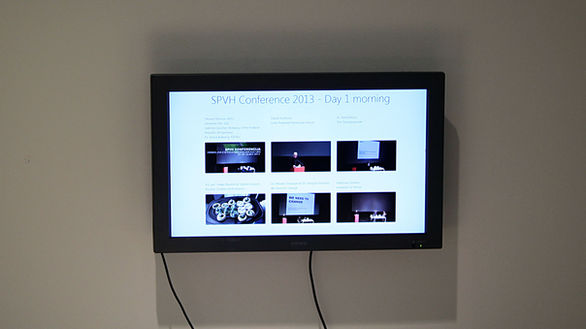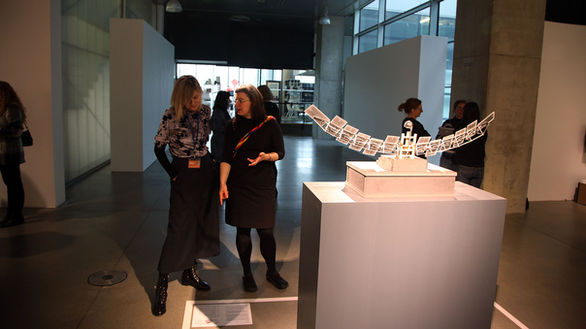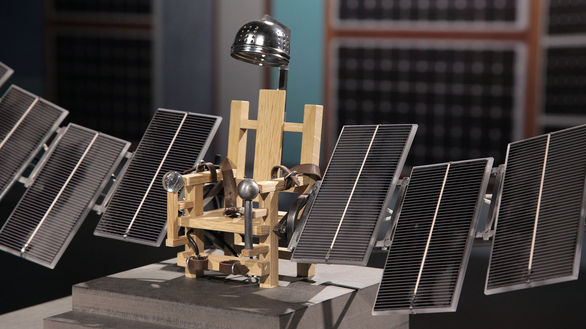photomontage, animated drawings, 2018
animated drawings, 2014
animated drawings, 2013
photomontages, 2011
Solar Powered Vernacular House
2013 - 2018
Solar Powered Vernacular House (SPVH) is an exhibition pavilion and think tank venue for renewable energies and sustainability issues. Based on a traditional Croatian wooden house, it has been developed for the roof of the MSU in Zagreb.
Imagining a better world where renewable energy sources like wind and solar are relieving some of the strain being imposed on nature - and therefore back upon ourselves - one has to ask the question whether human beings are capable of behaving in a sensible way. Or is the human need to transcend itself and its current condition such that it can only over-indulge, thereby missing the chance once again.
As part of a body of interactive sculptural installations which derive their power from solar energy, I wish to depict how our world might appear if we fail to break out of the vicious circle of events and established routines for structuring society as we know them today. I also wish to remind of the fact that many of these solutions and possibilities representing sustainable lifestyles have already been available for extended use for over 30-40 years, and in other cases much longer. I hope to raise awareness that the unavoidable transition to renewable energies will not turn into the next wave of elitists exploiting the masses, but will be developed in a way to serve the needs of the many.
Inevitably the MSU in Zagreb will need to outfit itself in the future with solar panels and thereby capitalize on renewable energies, reducing the financial burden of powering the various institutional activities. Within this context I propose a pavilion structure, a vernacular house, as an integrated element of these renewable energy systems. This structure, shaped like and with a construction similar to a traditional Croatian house, is completely covered with solar panels in one or more colors. The long southern wall has no windows, having five doors instead. The doors are also distinguished in that they are in motion, opening (via motion sensors) as passers-by approach the house and closing behind them after they enter. In front of and inside this pavilion, the spectator/passer-by is confronted by a series of objects representing some of the challenges in life: a door to nothingness, a pleasure chair, a barking watchdog, a polygraph machine, a running treadmill, a vibrator and an electric chair. Embodying issues relating to desires, honesty, guilt, and responsibility, the totality of these installations refers to the need of humans to live well and fulfill their search for pleasure and happiness, and their struggle in doing so.
All of these objects, as well as the doors, are powered from the solar panels on the pavilion. When presented independent of the pavilion structure, the objects all have their own integrated solar panel(s) as energy source, and are self-sufficient.
exhibition venue:
Museum of Contemporary Art Zagreb (MSU)
SPVH - End Presentation / Exhibition
2018
Solar Powered Vernacular House 2013-2018
Political Climate Change or State of Denial*
At the inaugural conference of the Solar Powered Vernacular House project in the MSU in 2013, it was stated that the causes for and means to prevent global warming have been known for decades. Furthermore, it was made clear that our responsibility as citizens, particularly cultural industry professionals, is to begin enacting long overdue energy related everyday adjustments in our private and professional lives. The point was made that a political climate change was desperately needed both worldwide and locally to counteract climate change, and that the goal of the project was to provide a forum for presenting and considering alternatives to the business as usual state of affairs and formulate concrete steps to improve the MSU’s energy efficiency.
Five years later, some progress with renewable energy has been made globally, but the end result is worse: the atmospheric CO2 levels continue to accelerate. The major industrial nations can't commit themselves to binding agreements to save energy and limit fossil fuel consumption. All the scientific data suggests that our ecosystems are at odds with unlimited economic growth, with unrestrained capitalism. Or, as Naomi Klein said, “... we have not done the things that are necessary to lower emissions because those things fundamentally conflict with deregulated capitalism, the reigning ideology for the entire period we have been struggling to find a way out of this crisis.” Put differently; if there is no other viable solution to fixing this imbalance other than a major structural shift away from the abuse of the personal profits ideology, away from the supremacy of capital and the tyrannical headlock of the banks to something more all-inclusive, then this shift must be considered.
So where does the MSU fit into all this? Is the MSU, one of the biggest museums on the national level, setting a positive example for Croatian society in terms of energy related responsibility? In this context, how can it set an example as one of the biggest contemporary art museums in south-eastern Europe? Has the new building contributed to more efficient administering of municipal cultural activities within the professional field of contemporary art? Should that be the main goal of investing in new premises? And if not, what will it take for the MSU to actively embrace a long-term commitment to overhauling its energy profile in a transparent way? Or, as Rafaella Zanatta from the EPEA formulated in her presentation in December 2015, “How could we implement a 25 year plan within the MSU to significantly reduce or even eliminate CO2 emissions, with the proposed pavilion as the first step in this process?”
The project documented in this publication was to find its long term home in a pavilion entitled “SPVH – Solar Powered Vernacular House”, proposed to be built as a solar power plant placed on the roof terrace of the MSU building. The plant was to be designed to function as an exhibition and work-space at once. The pavilion was to host shows, educational programs and collaborations, its mission being to strategically address wider audiences on sustainability issues as well as to implement energy efficiency solutions to the MSU building itself. Why is there a need for that?
The new building has mainly been a by-product of the big aspirations of local politics. If we continue pretending that the new museum building is great and interesting architecture, we will fail our historical duty related to energy issues. Moreover, these issues are deeply interconnected with various professional fields, in this case contemporary art. The building, in use now for 8 years, is in my opinion hardly sustainable. Within the building, I noticed one mechanical system in continuous conflict with another, producing additional workloads. Likewise, I have seen how the technical staff and building maintenance crew are constantly under pressure and overwhelmed by the competing curatorial expectations, followed by maintenance demands and management requests related to space rentals in order to generate income for building maintenance. The conclusion of an energy efficiency study can be formulated as follows: Caused to a great extent by the above mentioned energy inefficiency of its building, which then influences the working conditions, and in consequence the museum profile and function, the MSU has failed to foster a new bonanza of art and artists’ potentials in the country, as has been expected from the art community. This claim is even more true, considering that the resources trapped in the expensive overhead could potentially be invested in local artistic production and presentation.
During the SPVH project to date, I noticed two basic reaction patterns on the part of the museum and municipal administrations, when enquiring about the MSU energy efficiency profile. In practice, the initiatives presented to the public during the SPVH conference and workshops, documented in this publication, have for the most part been overlooked by the museum management and curatorial staff, and some concrete SPVH proposals have gone unheeded respectively by the city administration. The proposals involved promoting a change of attitude, a political climate change aimed to improve the building functions. The second reaction pattern was to embrace a proposal on a declarative level and then quickly give up on its realization. We can confirm that the SPVH project contributed to a certain extent to the positive flow of information about sustainable solutions to the museum’s energy problems. In several cases the MSU management seemed to have followed up on ideas generated by the SPVH workshops and established contacts. It is regrettable that these attempts have not been continued.
As far as I am informed, no significant comprehensive improvements have been made to date, March 2018, in terms of the energy efficiency of the MSU building. As initiator and author of the SPVH project, I keep posing myself a question: Has anything been learned to avoid similar future failures? Could the SPVH project possibly stimulate this important cultural institution to address the major cultural and civic issues of our times? From my point of view, I see the failures as an inherent structural part of local municipal and political hierarchies. I see that any future project of this kind needs to secure thorough preparation, transparent communication, and outspoken definition and agreement of common interests on the sides of the project initiators and involved institutions, as well as the local politics and municipal administration. In this respect the SPVH project could be either a missed chance or a chance that should not be missed, having already served mostly to expose this systemic dysfunctionalism, and having wanted to do much more. This leads to another question: What exactly do those who we have been delegated to oversee and manage the public goods need as a wake-up call for the serious and responsible energy efficiency work to begin?
*artist’s text from the exhibition publication: Solar Powered Vernacular House 2013-2018, David Smithson, MSU Zagreb (2018), pgs. 8-9.
Workshop Leaders/Speakers include:
Rafaela Zanatta, architect, EPEA Internationale Umweltforschung GmbH - Hamburg
Shelley Sacks, director, SSRU - Oxford
SPVH - Workshop III
2015
RENEWABLE ENERGY / RENEWABLE CULTURE
“Where can we go from here?”
This third SPVH Workshop will continue the discussions on sustainable practices, technical solutions and socio-political strategies introduced during the SPVH Conference 2013 and Workshops I & II, investigating more ways in which the SPVH program content could help clarify the identity of the museum’s rooftop activities.
During this one-day workshop in the Školica educational space at the MSU, our speaker topics will include:
1) an introduction to the Cradle to Cradle® Design Concept (C2C) in the Built Environment by the Environmental Protection Encouragement Agency (EPEA) in Hamburg, Germany. The history, mission and goals of EPEA, co-founder of the C2C methodology which provides the basics for the circular economy, will be presented through a brief overview of past and present projects. Relevant applications for the unfolding design of the SPVH Pavilion will be discussed.
2) the connective practices of the Social Sculpture Research Unit (SSRU) at Oxford Brookes University, highlighting the relationship between imagination and transformation. How ‘instruments of consciousness’ foreground the link between inner work and outer action, the ways ‘inner technologies’ can be mobilized through long-term collaborative projects such as University of the Trees (UOT) and Earth Forum, and how these practices might be introduced to the MSU audience as part of the extended SPVH Program, will be presented.
Workshop Leaders/Speakers include:
Dr. René Mono, political analyst (sustainable energy practices)
Gordan Cmrečki, architect - ORaH (sustainable policies)
Dr. Miljenko Haiman, structural engineer (wooden and steel structures)
Marina Zajec, architect (green building practices)
MSU_SPVH_Workshop_II_Invitation_ENG.pdf
MSU_SPVH_Workshop_II_Invitation_HR.pdf
SPVH - Workshop II
2015
RENEWABLE ENERGY / RENEWABLE CULTURE
“The Road to Environmental Justice”
With this second workshop in the SPVH Workshop Series, we continue looking for essential answers to the climate question, as we proceed with the SPVH Pavilion design. Clearly the necessary technological resources already exist to substantially reduce CO2 emissions, implying that the main battleground is primarily a political one. On the one hand, it seems almost every business is already “sustainable”, and on the other hand, far too few structural changes have taken effect. The “Energiewende” in Germany is faltering, and the EU appears further from rather than closer to any unified and coordinated vision which might effectively lead to improvements. This brings several questions to mind; With the low price of oil, will an effective carbon tax finally be implemented, thereby grounding environmental justice in a constitutional structure? Are the existing institutions - local, pan-European and global - equipped to affect the necessary changes or are they terminally hand-cuffed by special interests and conflicts of interest?
In the climate change debate the carbon tax issue is best exemplified by suggesting that “the polluter pays” (or should pay). Is an effective carbon tax realistic when simultaneously a major trade agreement like TTIP is being considered? And what role do the IMF and the World Bank play in this scenario?
During the two workshop days in the Školica educational spaces at the MSU, our speaker presentations will cover: 1) recent initiatives emerging from the stalling “Energiewende” in Germany, 2) energy issues and developments at the Croatian and EU institutional levels, 3) the superlative qualities of wood as a building material, 4) analysis and life cycle assessment of materials for the SPVH Pavilion.
Both workshop days are open to the public and will include time for questions and plenary discussions. In the morning on Day 2 participants will have the opportunity to present projects or issues (announced during registration) for inclusion in the discussion. In the afternoon on Day 2 a panel discussion - Carbon Tax Now! (and if not, why?) - will look at the larger picture of finally implementing a carbon tax.
Workshop Leaders/Speakers include:
Dr. Zdenko Šimić, energy scientist (risk and power)
Marina Zajec, architect (green building practices)
Dr. Dražen Šimleša, social scientist (sustainable development)
MSU_SPVH_Workshop_I_Invitation_ENG.pdf
MSU_SPVH_Workshop_I_Invitation_HR.pdf
Final analysis of a PV feasibility study for the roof of the MSU, researched by Denis Koren, student of Dr. Zdenko Šimić at FER, University of Zagreb (2015),
SPVH - Workshop I
2014
RENEWABLE ENERGY / RENEWABLE CULTURE
“Sustainable for whom?”
Sustainable for the designers?
Sustainable for the builders?
Sustainable for the owners?
Sustainable for the users?
Sustainable for the taxpayers?
Sustainable for the banks?
Sustainable for the politicians?
Sustainable for nature?
Sustainable for future generations?
With this first workshop in the SPVH Workshop Series, we follow through with the objectives stated at the SPVH Conference in 2013. The focus is to stimulate a comprehensive discussion about renewable energies - and renewing culture - by incorporating the principles and practices of sustainable energy into our everyday lives. Our goal is for the MSU to set a good example for other public institutions about the best approaches to an energy profile overhaul.
The project seeks to show that the transition to renewable energy does not need to take place at the expense of the uninformed mass population, with profits only for the elite, as is often the case with the mass application of technologies. This transition can develop through democratic structures based on horizontal social networking, in a way that serves everyone without becoming the next trap for the general population.
During the three workshop days in the Školica educational spaces at the MSU, the speaker presentations will cover; 1) the implementation and risks of renewable energies, 2) green building practices, and 3) sustainable development and mobilization strategies in civil society. Potential applications to improve the museum’s energy profile, and design aspects of the proposed roof-top educational pavilion - inspired by a traditional Croatian wooden house - will serve as immediate case studies. Parameters for installing photovoltaic power plants on building roofs, analyzing covered local consumption, economics and CO2 impact, will be presented. Numerous examples of alternative methods of building construction and sustainable practices in architecture, particularly the opportunities provided by straw-bale house construction, will be spotlighted, giving special attention to the environmental impact of the materials selected for a building.
Models for impacting and renewing society with a focus on economic and policy level decisions, using historical examples and current initiatives as references, will stimulate interdisciplinary thinking about renewable energies and sustainability among young professionals.
All workshop days are open to the public and will include smaller task groups (Day 2 and Day 3) and plenary discussions. In the morning on Day 2 participants will have the opportunity to present projects or issues (announced during registration) for inclusion in the discussion. In the afternoon on Day 2 a panel discussion will look at the larger picture of energy production and the environment.
On Friday, November 28th at 4 pm DOOR will present the CLICK Award Ceremony.
Speakers include:
Nikola Bašić, architect
Dr. Vesna Bukarica, FZOEU
Dr. Mladen Domazet & Dr. Danijela Dolenec, social scientists
Dr. Maja Božičević Vrhovčak, DOOR
Drs. Maja & Reuben Fowkes, curators
Igor Franić, architect
Davor Fulanović, curator
Ivica Gjurić, architect
Adrienne Goehler, curator - publicist
Mirela Holy, Ph.D., politician
Vedran Horvat, HBS Zagreb
Deborah Hustić, Gjino Šutić i Davor Jadrijević, artists - activists
Dr. Vladimir Lay, social scientist
Dr. Konrad Mertens, photovoltaic scientist
Ljubomir Miščević, architect
Dr. René Mono, 100% erneuerbar stiftung
431 art - Haike Rausch & Torsten Grosch, artists - activists
Shelley Sacks, artist - activist
Antje Schiffers & Thomas Sprenger, artists
David Smithson, artist
Dr. Dražen Šimleša, social scientist
Solar Powered Vernacular House (SPVH) - Conference
2013
RENEWABLE ENERGY / RENEWABLE CULTURE
November 29-30, 2013
Global warming is a harsh reality, and the exploitation of renewable energy sources is an urgent need. According to a recent statement by the Croatian Government in accordance with its accession to the EU, Croatia has to provide 23.6% of its energy needs from renewable sources by 2030. With this conference we want to make a contribution in this direction. In contrast, the change in energy policy (Energiewende) is one of the most relevant public debates in the EU, and especially Germany, in recent years. It includes the entire public sphere, in which artists and political activists have a significant role. The German experience with energy transition is highly instructive, setting an example within the context of Europe, and could be of benefit to both a specialized and also a wider audience in Croatia.
This conference is a project of cultural exchange and education on energy and sustainable transition, intended as an exchange between Germany, Croatia and the region. The aim is to accelerate the process of thinking about renewable energy and sustainability at the micro and macro levels, the special target audience being cultural workers; cultural and political activists, artists, designers, architects, professionals in the creative industry, and students. As already demonstrated in several exemplary European countries, these social groups are the most capable for introducing sustainable energy issues into the central public discourse.
The main goal of the conference is to motivate the audience to take an active role and make an impact on their professional environment - to start acting as examples as they reconstruct their own work environments - or their (public) institutions - on the principles of energy efficiency. As organizers, we want the MSU to set a good example of an institution that could be and should be energetically reprogrammed - having in mind the unsustainability of the MSU building energy needs, that is, its architectural and energy profile.
The project seeks to show that the transition to renewable energy does not need to take place at the expense of the uninformed mass population, with profits only for the elite, as is often the case with the mass application of technologies. This transition can develop through democratic structures based on horizontal social networking, in a way that serves everyone. In this sense, the goal of the conference is to educate how to incorporate the principles of sustainable energy into their/our everyday lives.
A number of international and Croatian speakers will cover a spectrum of themes and issues. Presentations and discussions will focus on relevant issues related to energy consumption, the environmental impact of the food chain, alternative methods of construction including the energy "overhaul" of existing buildings and public institutions, all in the context of the new economic energy models and civil society in development. Examples of related interdisciplinary artistic practices will be featured as well. There will be plenary discussions aimed at actively engaging the audience.
We hope that all participants will walk out with one new motivational idea about sustainability, renewables and what you could do next.



















































































































